#pigeon history deep dive
Text

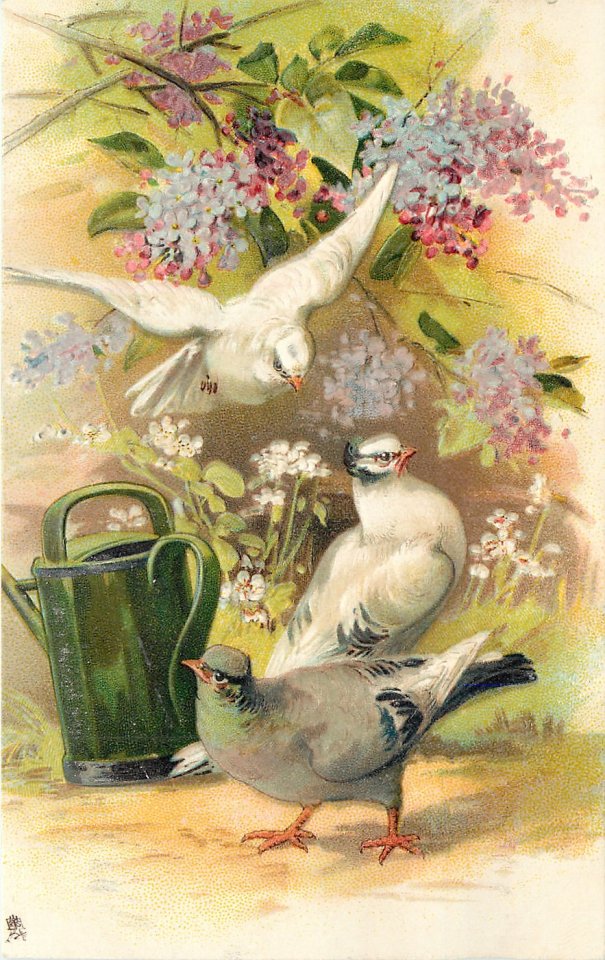

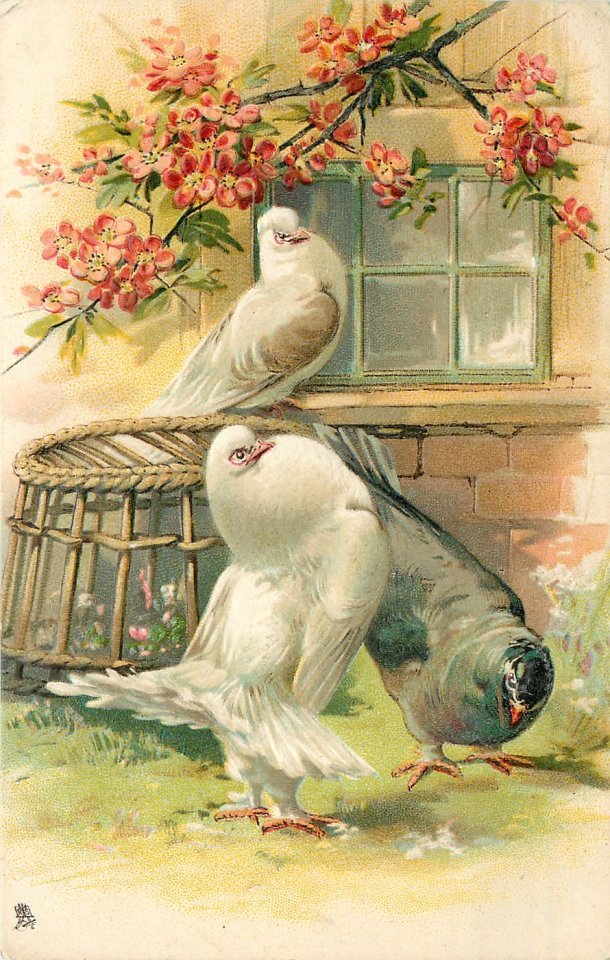
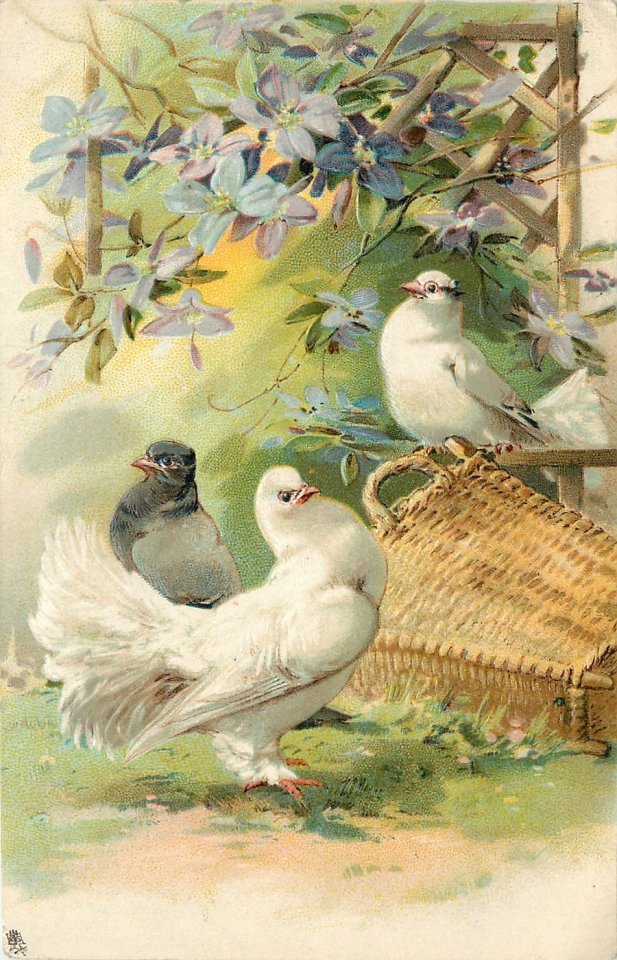
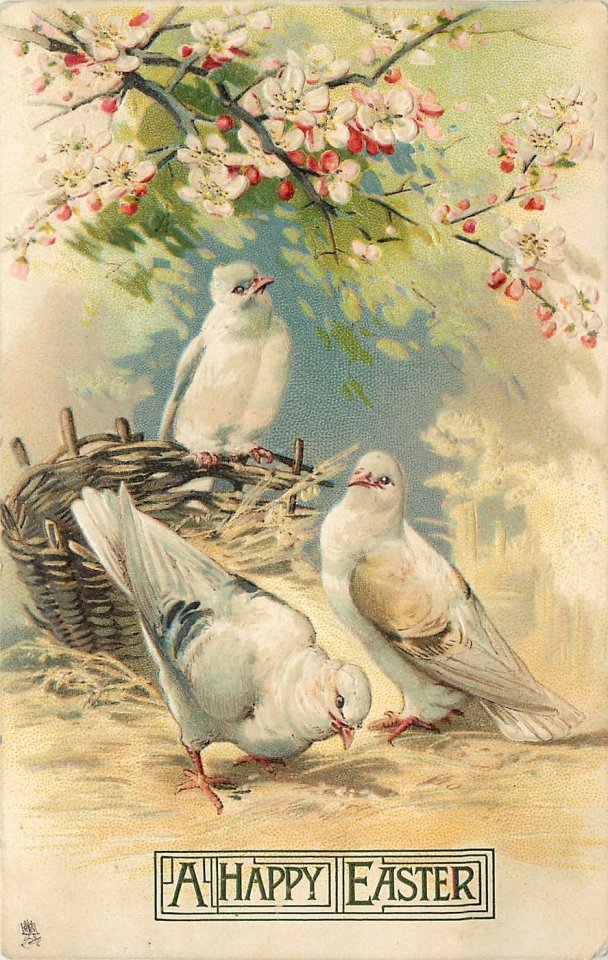
"Pigeons in Springtime" postcards (1909)
521 notes
·
View notes
Text
fun with tags! thank you to the @thetomboyeffect for tagging me I haven't done anything like this since Deviantart -- 15 questions for 15 mutuals:
were you named after anyone?
Martin Fry, Martin Short, and Marty Mcfly.
do you have kids?
No.
do you use sarcasm a lot?
I use sarcasm a reasonable amount I think. I wouldn't consider myself a sarcastic person, but I dabble.
what's the first thing you notice about people?
Speech patterns and ankles.
what's your eye color?
Bluish-greenish flecks of brownish, desaturated about 60%.
scary movies or happy endings?
Horror movies with survivors.
any special talents?
Outfit coordination, rhythm matching, business speak, detecting hazardous gases, petting cats, and I guess, if we are counting art, art.
what are your hobbies?
deep diving the jim bakker PTL scandal, accumulating a concerning amount of information about bob dylan, churning out old people, poetry, learning harmonica/acoustic guitar, polaroid photography (when I buy film), collecting records and rusty tools, and prompting people to pull their face into a very particular expression of confusion and disgust.
have any pets?
A pigeon, a cockatiel, and my impulse control.
what sports do you play/have you played?
Not a sportshead, but I ran for an aerobics class in high school.
how tall are you?
5'7"
favorite subject in school?
English, occasionally. Persuasive essay portions sucked. But if I had an especially passionate teacher that year, History.
dream job?
a lack of job without fear of starvation or homelessness.
3 notes
·
View notes
Text
Blog Post #3
"Pressure”(Ezra Clayton Daniels) "The Most Strongest Obeah Woman of the World"(Nalo Hopkinson), Ouanga/Love Wanga (1936) Candyman (dir. Bernard Rose) Candyman (dir. Nia DaCosta)
I lived in Chicago from 2010 to 2022, during that time I received my undergraduate and began a true deep dive into horror. I had dabbled a little while as a teenager watching what I could find at the time on cable network television primarily Wes Craven, John Carpenter, and Stephen King but not till college …studying photography…taking a Porn and Censorship course … did I watch French Extremist Horror for class and finally think I was brave enough to dig through my schools extensive DVD collection for all the horror I could find.
I found the original Candyman my Junior year, I was still living in the dorms then off State St in the center of the Loop in Chicago. I accidentally had a streak of watching films I didn’t know took place in Chi … I had watched The Relic and then Child’s Play (for the first as an adult) and was shocked to realize both films had been shot just only a few block away from where I was living at the time. That hardly compared to the genuine fear I had watching Candyman and seeing that the architecture of the dorms mimicked that of Cabrini Green and Helen’s Apartment complex - down to the restrooms and the mirrored cabinets that could easily allow access to neighboring dorm rooms. CHILLS. I had learned a lot about Cabrini through the mandatory Chicago history reading pushed out to all freshmen but hadn’t heard about the movie.
For me the first film from a white perspective gets the tone right … for the most part, a lot of my rich white and sheltered peers at school looked at Chicago as a predominantly black and brown city and stepped outside either in fear or sought to analyze Chicago as an anthropological research site. So though it may not have been purposeful Bernard Rose paints an experience I lived through like Bernadette working through financial and racist bias within academia while next to white peers who believe they are making groundbreaking work still seated within their white guilt, privilege, and bigotry. Candyman has always been about art, writing, and the historical discourse of redlining, gentrification, hate crimes, and the consumption of the black body and black trauma for white audiences. I once had a screening (24-hour Horror movie marathon) themed around The Lips, The Teeth, The Tip of the Tongue. Link It was split across three days Taste, Chew, Shallow - the last day Swallow I pair Candyman with Ganga and Hess and it opens up a dialogue connecting the two films around martyrdom, transformation, and the use of spiritual transcends.
Nia DaCosta’s spiritual sequel is hands down one of my favorite films. Prior to/during filming I was working at the Museum of Contemporary Art Chicago, had curator friends who lived in the Marina Towers, and had become friends/acquaintances with featured artists in the film. It was so eerie to see my world once again reflected at but now with more knowledge about myself and the world. It was and still is dizzying and nauseating to watch I have rarly experience watching cinema. While also being so powerful narratively, metaphysical, and thematically. Not to mention it boosting the careers of real-life young black artists and cementing their work within the history of Black art and Cinema.
The mirroring structure, the callbacks, the new black perspective on Cabrini, The black female lead, the equality and diversity of the cast (specifically having queer actors play queer roles), the READING of the art world, and the pigeon-holding of black creatives - all brilliant, considered, and still truly terrifying.
Lastly linking the two films to Pressure also opens up a lot of the same points and I kind of imagine that within his pressured familial environment may reflect some of the same insecurities and concerns Anthony may have that lead to a different type of internal dismantling and enviable combustion.
0 notes
Text
Natural Ruby Gemstone: Unveiling the Beauty and Mystique
Unlock the secrets of the Natural Ruby Gemstone in this comprehensive guide. Explore its origin, properties, and significance. Discover the allure of this exquisite gem.
Introduction:
Welcome to the enchanting world of the Natural Ruby Gemstone. In this guide, we embark on a journey to unravel the mysteries behind this precious gem. From its geological formation to cultural significance, this article delves into every facet, ensuring you become well-versed in the allure of the Natural Ruby Gemstone.
The Origin Story
Formation of Natural Ruby Gemstone:
Embark on a geological journey as we explore how the Natural Ruby Gemstone is born. Created under intense pressure and heat, these gems captivate with their vibrant red hues, making each one a unique masterpiece of nature.
Geographic Riches:
Discover the regions where these treasures lie hidden beneath the Earth's surface. From the mines of Myanmar to the corundum-rich fields of Thailand, each locale contributes to the gem's distinct characteristics, making it a truly global phenomenon.
Natural Ruby Gemstone: A Closer Look
Physical Characteristics:
Dive into the physical attributes of the xx. From its hardness on the Mohs scale to its crystal structure, understanding these aspects enhances appreciation for its durability and beauty.
Color Variations:
Explore the spectrum of reds that adorn these gems. From pigeon blood to deep burgundy, each shade tells a story, reflecting the diverse landscapes where these gems originate.
Inclusions: Nature's Fingerprints:
Uncover the unique inclusions within Natural Ruby Gemstones, often referred to as "silk" or "needles." These imperfections add character and serve as nature's fingerprints on these precious stones.
The Cultural Tapestry
Historical Significance:
Delve into the rich history and cultural significance of the Natural Ruby Gemstone. From ancient civilizations to modern-day, this gem has adorned royalty and symbolized passion and power.
Astrological Influences:
Explore the mystical beliefs surrounding the Natural Ruby Gemstone. According to astrology, this gem is linked with passion, love, and prosperity. Discover how wearing it may influence your destiny.
Investing in Timeless Elegance
Market Trends:
Navigate the dynamic world of gemstone investments. Uncover insights into market trends, understanding why the Natural Ruby Gemstone is not just a stunning accessory but also a valuable asset.
Caring for Your Natural Ruby Gemstone:
Learn essential tips on maintaining the brilliance of your gem. From cleaning methods to avoiding common pitfalls, ensuring the longevity of your Natural Ruby Gemstone is crucial.
Natural Ruby Gemstone - Your Questions Answered
Are Natural Ruby Gemstones Rare?
Absolutely! The rarity of Natural Ruby Gemstones adds to their allure. Their scarcity in nature makes them highly coveted and valuable.
Can Natural Ruby Gemstones Change Color?
While rare, Natural Ruby Gemstones can exhibit color change under different lighting conditions. This phenomenon, known as alexandrite effect, adds a captivating dimension to these gems.
How to Authenticate a Natural Ruby Gemstone?
Consulting a certified gemologist is crucial for authentication. They employ various tests, including microscopic examination and spectroscopy, to verify the gem's authenticity.
Do Natural Ruby Gemstones Have Healing Properties?
In various cultures, Natural Ruby Gemstones are believed to have healing properties, fostering vitality and passion. However, it's essential to approach such claims with an open mind and seek professional advice.
What is the Ideal Setting for a Natural Ruby Gemstone?
The durability of the Natural Ruby Gemstone allows for versatile settings. Whether embraced by gold or nestled in platinum, the choice depends on personal style and preferences.
Can Natural Ruby Gemstones Fade Over Time?
Under proper care, Natural Ruby Gemstones maintain their vibrancy. However, prolonged exposure to sunlight and harsh chemicals may impact their color over an extended period.
Conclusion:
As we conclude our exploration of the Natural Ruby Gemstone, it's evident that this gem transcends its mineral composition. It embodies history, culture, and timeless elegance, making it a cherished symbol of passion and prosperity. Invest wisely, care thoughtfully, and let the allure of the Natural Ruby Gemstone accompany you on life's journey.
0 notes
Text
Learn Complete SEO Course in 24 hours | Full SEO Course in Hindi | SEO Tutorial | Part 1 | #113
Complete SEO Course Part 1: https://youtu.be/Y0XwYVL2sVA
Full SEO Course Playlist in Hindi: https://www.youtube.com/playlist?list=PLq3mt7JTwE9GZ3V8KmZFK-R4vm1joy_rX
Welcome to Part 1 of our Complete SEO Course, an epic 12-hour journey into the heart of digital optimization! 🚀
Chapters Covered:
History of SEO: Journey through the evolution of SEO and understand its impact on the digital landscape.
What is SEO?: Demystify the core concepts that define Search Engine Optimization.
On-Page SEO: Master the art of optimizing your web pages for maximum visibility and user experience.
Off-Page SEO: Explore strategies beyond your website to enhance your online presence.
Technical SEO: Delve into the technical intricacies that influence search engine rankings.
How Search Engines Work: Uncover the mechanics behind search engines and how they rank content.
SEO Hat Trilogy: Understand the nuances of White Hat, Black Hat, and Grey Hat SEO practices.
Google Search Console Tutorial: Navigate the powerful tool for monitoring and optimizing your site's performance.
Google Algorithms Unveiled: Explore Panda, Penguin, Hummingbird, and other critical algorithms shaping search results.
Core Web Vitals Series: Dive deep into LCP, FID, and CLS, crucial metrics for user experience.
Google E-A-T: Grasp the importance of Expertise, Authoritativeness, and Trustworthiness in content creation.
On-Page SEO Best Practices: Receive a comprehensive checklist for optimizing your on-page elements.
Title Tags, Meta Descriptions, and Headings: Craft compelling elements for higher click-through rates.
URL, Image, and Alt Text Optimization: Elevate your content's visual and structural appeal.
Links Galore: Understand internal, external, and backlinks, and their impact on SEO.
DoFollow and NoFollow Backlinks: Unravel the mysteries of different backlink types.
Types of Backlinks: Explore guest blogging, article submission, social bookmarking, and infographic strategies.
History of SEO
What is SEO?
On-Page SEO
Off-Page SEO
Technical SEO
How Search Engine Works
White Hat SEO, Black Hat SEO and Grey Hat SEO
Google Search Console Tutorial
Top Important Google Algorithms-Panda, Penguin, Hummingbird, Pigeon, Rankbrain, Mobilegeddon, Possum and Fred, Page Experience
Core Web Vitals Series | Largest Contentful Paint (LCP), First Input Delay (FID), Cumulative Layout Shift (CLS)
Google E-A-T
On-Page SEO Checklist
How to Write Perfect Title Tags For SEO
Meta Description Optimization
How to create SEO Friendly Heading Tag | H1, H2, H3
URL Optimization
Image Optimization
How to Write Alt Text for Image
Anchor Text SEO | What is it & how to optimize It?
Internal Links & External Links
Backlinks in SEO
What are DoFollow and NoFollow Backlinks?
Types of Backlinks-Guest Blogging Backlinks, Article Submission, Social Bookmarking, Infographic Submission
Buckle up for this SEO odyssey! 🌐✨
YouTube Channel: https://www.youtube.com/@LuxmiShanker
Instagram: https://www.instagram.com/luxmi_shanker
Facebook: https://www.facebook.com/luxmi.shanker?mibextid=9R9pXO
Twitter: https://twitter.com/LuxmiShanker?t=16QtlNhmp_KeEzmuC9Rcjg&s=08
WhatsApp Channel: https://whatsapp.com/channel/0029VaAxu9JFi8xi71MvUi3x
#SEOCourse#DigitalMarketing#SEOExplained#SearchEngineOptimization#GoogleAlgorithms#WebVitals#TechnicalSEO#ContentOptimization#BacklinkStrategies#GoogleSearchConsole#SEOTutorial
0 notes
Text
Unveiling the Enchanting Wonders of Cappadocia

Hey Tumblr fam! 👋 Today, I want to take you on a virtual journey to one of Turkey's most captivating destinations: Cappadocia. 🏰✨ Brace yourselves for a breathtaking experience as we explore the best things to do in this enchanting region.
Read full Blog from the link given below:
Grab a cup of tea and let's dive in!
Hot Air Balloon Ride:
Picture yourself floating above a fairytale-like landscape, with colorful hot air balloons dotting the sky. 🎈🌄 A hot air balloon ride at sunrise is an absolute must-do in Cappadocia. Soak in the mesmerizing views of the unique rock formations, known as "fairy chimneys," and capture some awe-inspiring photos that will leave your followers in awe. #BucketListGoals
Göreme Open-Air Museum:
Step into an ancient world by exploring the Göreme Open-Air Museum, a UNESCO World Heritage Site. 🏛️🌳 Wander through the rock-cut churches adorned with stunning frescoes that date back to the Byzantine era. This place is a hidden gem for history buffs and art enthusiasts alike. Don't forget to take a moment to soak in the serene atmosphere and reflect on the rich cultural heritage of the region. #HistoricalGems
Underground Cities:
Venture deep below the surface and discover the mysterious underground cities of Cappadocia. 🕳️🔦 These subterranean marvels were carved out of soft volcanic rock, serving as hiding places for early Christian communities. Explore the winding tunnels, secret chambers, and even a chapel hidden within the depths. It's like stepping into a real-life adventure movie! #HiddenWonders
Hiking Trails:
For the nature lovers and avid hikers among us, Cappadocia offers an array of stunning trails to explore. 🥾🌿 Embark on a hike through the picturesque Rose Valley, Love Valley, or Pigeon Valley, and be prepared to be mesmerized by the surreal rock formations, lush vineyards, and panoramic views at every turn. Don't forget to bring your camera to capture the awe-inspiring beauty of the region. #NatureLovers
Turkish Cuisine Delights:
No travel experience is complete without indulging in the local cuisine, and Cappadocia won't disappoint your taste buds. 🍽️😋 Savor traditional Turkish dishes like Gözleme (stuffed flatbread), Testi Kebab (cooked in a clay pot), and the delectable dessert Künefe. Pair your meals with a glass of locally produced wine and embrace the culinary delights of the region. #FoodieHeaven
So, Tumblr fam, are you ready to add Cappadocia to your travel bucket list? ✈️✨ Let this magical destination cast its spell on you as you explore its surreal landscapes, delve into its ancient history, and create memories that will last a lifetime. Trust me, your followers will thank you for sharing the wonder of Cappadocia.
Happy exploring, wanderers! 🌍❤️
#Cappadocia#TravelInspiration#BucketListGoals#HistoricalGems#HiddenWonders#NatureLovers#FoodieHeaven#CappadociaMagic#Wanderlust#TravelAdventures#ExploreTheWorld#EnchantingDestinations#UNESCOWorldHeritage#HotAirBalloonRide#GöremeOpenAirMuseum#UndergroundCities#HikingTrails#TurkishCuisine#TravelMemories#SurrealLandscapes#AncientHistory#CulturalHeritage#AdventureAwaits#InstaTravel#TravelPhotography#TravelCommunity#VirtualJourney#CaptureTheMoment#MagicalExperiences#.
1 note
·
View note
Text
What Makes Lebanon a Touristic Country?

Lebanon, nestled in the heart of the Middle East, is a captivating country that offers a myriad of attractions for travelers. From breathtaking natural landscapes to historical treasures and a vibrant modern lifestyle, Lebanon has it all. This small nation is a true gem, attracting tourists from around the world.
So, what makes Lebanon a touristic country? Let's delve into the enchanting wonders that await visitors in this fascinating destination.
Natural Beauty of Lebanon
Lebanon boasts a stunning natural landscape that captivates visitors at every turn. From the picturesque coastal areas along the Mediterranean Sea to the majestic mountain ranges of the Lebanese Alps, the country offers diverse and breathtaking scenery. The legendary Cedars of Lebanon, a symbol of the nation's resilience, provide a truly magical experience.
The Qadisha Valley, a UNESCO World Heritage Site, is another natural wonder. This deep gorge is home to ancient monasteries and offers incredible hiking trails for nature enthusiasts. The Beqaa Valley, with its lush vineyards and fertile plains, is renowned for its wine production and scenic beauty.
Historical Heritage
Lebanon is a country steeped in history, with a rich heritage dating back thousands of years. The ruins of ancient civilizations, such as Baalbek and Byblos, offer a glimpse into the past. Baalbek's colossal Roman temples and Byblos' well-preserved Phoenician ruins are a testament to Lebanon's historical significance.
The vibrant capital city of Beirut showcases a blend of ancient and modern architecture. Visitors can explore Roman baths, and Ottoman-era buildings, and marvel at the iconic Pigeon Rocks. The National Museum of Beirut houses an impressive collection of artifacts, providing insight into Lebanon's diverse heritage.
Vibrant Cities and Culture
Lebanon's cities are vibrant and pulsating with energy. Beirut, known as the "Paris of the Middle East," offers a cosmopolitan lifestyle with a Mediterranean flair. The city boasts trendy neighborhoods, designer boutiques, and a thriving nightlife scene. Stroll along the Corniche, enjoy a cup of coffee in a stylish café, or immerse yourself in the bustling souks.
Tripoli, Lebanon's second-largest city, is a cultural treasure trove. Its old town, a UNESCO World Heritage Site, enchants visitors with its labyrinthine alleys, grand mosques, and Ottoman-era architecture. Byblos, one of the world's oldest continuously inhabited cities, exudes charm with its ancient port, Crusader castle, and vibrant arts scene.
Culinary Delights
Lebanese cuisine is renowned worldwide for its delectable flavors and fresh ingredients. Food lovers will be in gastronomic heaven as they savor mezze, a variety of small dishes, including hummus, tabbouleh, and falafel. Indulge in mouthwatering kebabs and shawarma, accompanied by fragrant rice and grilled vegetables.
Lebanon's thriving street food culture is a must-try for visitors. Explore the bustling streets and savor the irresistible flavors of manakish (Lebanese pizza), kaak (sesame bread rings), and sweet pastries like baklava. Don't forget to enjoy a cup of strong Lebanese coffee and satisfy your sweet tooth with a taste of traditional Arabic sweets.
Adventure Activities
For those seeking outdoor adventures, Lebanon offers a wide range of activities. The country's diverse topography makes it ideal for hiking, skiing, and water sports. Hit the slopes in the winter and enjoy skiing or snowboarding in the Lebanese mountains. In the summer, head to the coast for thrilling water sports, including snorkeling, diving, and sailing.
Lebanon's countryside is dotted with hiking trails that lead to hidden gems. Explore the Qadisha Valley's rugged terrain, discover hidden waterfalls, and witness breathtaking panoramic views. The Jeita Grotto, a mesmerizing cave system, invites visitors to explore its magnificent chambers and underground river.
Lebanese Hospitality
Lebanese people are renowned for their warm hospitality and welcoming nature. Visitors to Lebanon often find themselves embraced by the locals' genuine warmth and friendliness. From the moment you step foot in the country, you'll be greeted with open arms and made to feel at home.
Lebanese hospitality extends to the concept of "tarboush," meaning going the extra mile to make guests feel comfortable. Whether it's sharing a meal, offering directions, or engaging in heartfelt conversations, the people of Lebanon go out of their way to ensure visitors have a memorable experience.
Questions and Answers
Q: Is Lebanon safe for tourists?
A: Yes, Lebanon is generally safe for tourists. However, it's advisable to stay updated on the current situation and follow travel advisories.
Q: What are the best times to visit Lebanon?
A: The best times to visit Lebanon are during spring (April-May) and autumn (September-November) when the weather is pleasant and mild.
Q: What are some lesser-known attractions in Lebanon?
A: Some lesser-known attractions in Lebanon include the Cedars of God, the village of Deir el Qamar, and the charming coastal town of Batroun.
Conclusion
In conclusion, Lebanon's appeal as a touristic country lies in its diverse range of attractions. From the natural beauty of its landscapes and historical heritage to its vibrant cities, delicious cuisine, and warm hospitality, Lebanon offers a truly unforgettable experience.
Whether you seek adventure, culture, or relaxation, this enchanting destination has something to offer everyone. So, pack your bags and embark on a journey to discover the wonders that make Lebanon a must-visit tourist destination.
1 note
·
View note
Text
My Month in Books: February 2023
I read two books this month. Which is the baseline goal for me every month. I reealized I've been reading (or listening) to slightly longer books recently. Which could be a huge part of what seems like a reading slump for me. Also, I'm clinically depressed so. You know. Anyway! I'm excited to dig into next month's books:
1. The Pigeon Tunnel by John le Carre: This is John le Carre's version of a memoir, so really an assemblage of recollections and anecdotes on a theme. le Carre is such a good writer and it made me want to really do a deep dive into his work. He has a thoughtful and unique perspective on politics and the postwar period--his strong stance on American interventionism in Germany, the surveillance state, torture, the state of Cold War intelligence services were all fascinating to read. It is not a deeply personal book--in some cases, I felt some additional context could have been helpful, like his tirade against Kim Philby being informed by the fact that Philby was the reason his cover in Germany was compromised and prompted his leaving MI6--until the end where he writes a masterful essay on his relationship to his parents, especially his father. (Though his description of his mother's departure and the sexual perversion of her white leather suitcase is just--he is such a good writer!!!!) The ending essay on the "green box" is just a mic drop. I really, really need to read more of this man.
2. The Memoirs of Stockholm Sven by Nathaniel Ian Miller: I can't decide how I feel about this book. I thought the subject was interesting, the characters endearing, and the writing very good. But it was also a lot of telling, rather than showing. It made sense as a "memoir" but like...i wanted some more unreliability, more use of the first-person voice. This is also a very, very queer book which is interesting. Almost every other character, except for Sven himself, is gay or asexual which...it makes sense that all these marginalized people float to this marginalized corner of the world but it did leave Sven as this sort of lone straight white man just learning to be an ally lol. It was an interesting book about an interesting part of the world in an interesting moment of history...I'm glad I read it and I'll keep an eye out if Miller decides to write anymore. Recommended by my dad.
#the memoirs of Stockholm Sven#Nathaniel Ian Miller#the pigeon tunnel#john le carre#my month in books
0 notes
Text
Best Vacation Spots in Bahamas

When beach lovers dream of the perfect stretch of powdery sand, lapped by seas in sublime shades of blue, they're probably dreaming of the Bahamas. Encompassing 700 islands and more than 2,000 small cays sprinkled across the Atlantic Ocean and Caribbean Sea, there are plenty of vacation spots in Bahamas.
Once a haven for pirates and Loyalists, the island country now serves as a vacation paradise for anyone who enjoys world-class fishing, boating, diving, snorkeling, and sailing. Hence, once you catch glimpses of powdered sand and 50 shades of blue in the waters, you know you have entered this magnificent place!
Apparently, this bustling country is a mix of mega resorts, beaches, shops, restaurants, and entertainment complexes. So, let us find out more about the tourist attractions to check out here when you take cheap flights to the Bahamas.
The Grand Bahama

Grand Bahama is a stunning island and is always included in the itineraries of all travelers ranging from budget backpackers to luxurious cruise tours. The beaches are stunning and a perfect depiction of Bahamian culture for the tourists. Besides, visiting here is considered one of the best things to do in Bahamas. Apart from just lounging and getting a perfect tan on the beach, one can also shop for beach jewelry and crafted straw goods or head to one of the many restaurants to enjoy a nice drink and a meal!
Nassau

It is one of the most popular cruise ship ports in the Caribbean, and serves as the most breathtaking capital city, despite heavy crowds. When it comes to finding attractions for tourists in Bahamas, there are plenty of options. Bask on the white sands of Cable Beach; explore the museums, and candy-colored colonial buildings of downtown and Bay Street; and shop for souvenirs at the Nassau Straw Market.
Exuma Cays and Land Park

Exuma Cays Land & Sea Park has some of the most striking seascapes in the island country. Nestled in Eastern Bahamas, this is basically a marine secured area and is the first of its kind in the Caribbean region. One can discover some of the most exotic seascapes as well as enjoy water sports here. Here you can mix shades of electric blue merging with bone-white sand, and creating a stunning panorama for a range of marine adventures. Moreover, the area is popular amongst divers and boaters around the world, who come here for the quality anchorages, abundant marine life, and crystal-clear waters.
Biminis

Biminis is known as the "Big Game Fishing Capital of The Bahamas," and for a good reason. The island hosts popular deep-sea fishing tournaments from March to September, and its proximity to the warm waters of the Gulf Stream lure a dazzling diversity of marine life, including everything from marlin to mahi-mahi and manta rays. Furthermore, the fishhook-shaped cluster of islands includes North Bimini, South Bimini, and numerous cays extending south from Pigeon Cay to South Cat Cay. Bimini Island is the closest island to the United States, lying approximately 88 kilometers east of Miami, Florida. Being one of the prominent vacation spots in Bahamas, its fish-rich waters also offer excellent opportunities for diving and snorkeling.
Pirate Museum

It is considered as the best place to visit in Bahamas. Built in 1716, this museum has been a part of thousands of intriguing stories, passed down from one generation to the next. Moreover, visiting this museum is an interactive experience, enjoyed by adults and children alike. Interestingly, Nassau has been a favorite amongst pirates owing to its unbeatable harbor, which helped them plan attacks on many trading routes. The museum perfectly portrays the events held during the “Pirate era,” and contains many elements that are relatable to those times.
Conclusion
These were the top vacation spots in Bahamas, which you can check out when planning a vacation here. From magnificent beaches to alluring cays and museums, the island country has an abundance of beauty and rich history. Spending a vacation here will bring you close to the exotic marine life of the Caribbean Sea, and is a perfect place to indulge in different water sports.
#Bahamas#LFF#lowestflightfare#vacayvibes#travel#famous place#places to visit#beach#trip#amazingnature#holiday
1 note
·
View note
Text
Best 5 DIY Decor Ideas For College Dorm Room
Colleges have evolved from austere learning centers to more relaxed venues reminiscent of country clubs. Rutgers University’s $55 million Rockoff dorm features a Coldstone Creamery and a next-century gym, while MIT has a ball pit and Boston University has a climbing wall.
In this setting, dorm decor has come to resemble a competitive sport, with design-savvy students betting on their imagination to decorate their space with style. Check out our top 5 DIY decor ideas for college dorm rooms to get inspired and make your dorm the talk of the town!
1. Inspirational phrases
Dorm room decor that includes inspirational sayings or quotes is very trendy right now. You might walk by a classmate's dorm and see the phrase "You're not a pigeon, you're a unicorn" artfully typeset on his wall, or a pillow with the phrase "C'est la vie" on it. Wouldn't this be a refreshing experience after a long day of exam prep or honing your writing skills with professional trust my paper services? We think it would. Even if you find motivational sayings corny, you can pull them off with a creative flair. Instead of outmoded old adages, you could opt for fancy typography.
2. Relax in style
Decorating your sleeping space to turn it into an intimate relaxation area can transport you back to the safety of the womb. This could mean hanging an elegant curtain, investing in top-quality mattresses and pillows that are also tastefully decorated, or placing a sunflower beside your bed.
Choosing comfortable bedding is likewise essential if you want your dorm room to feel like a home away from home. What's more, it shall grant you a good night's sleep, which is essential for your health. This is the case when you can chase two rabbits and catch both: your bedding can be functional (helpful for a good night's sleep) and aesthetically pleasing (a nice addition to your decor).
3. Borrowing from nature
Have you ever wondered what makes some dorm rooms feel so inviting and warm? It's not just because you're a fan of your friend’s posters or enjoy the company, though, both count. It's because your college buddy understands that any space feels more authentic if embellished with natural fibers such as wood, wool, or wicker. Adding decor elements sourced from mother nature will ensure your dorm room radiates an instant homey feel.
Though taking design cues from nature is nothing new, the trend is seeing renewed popularity among college students as part of a wider greenery trend.
4. The power of color
It doesn't require much head-scratching to understand how colors can lift our moods. Colors have energy frequencies; we're directly influenced by being around them.
Revive your dorm room with colors that make you happiest. Arranging a visual landscape will not only add to the overall decor of your room but also instill a sense of calm. Add flashes of on-trend neon to liven up your compact flat, and opt for relaxing blues for setting up your study corner.
5. Accessories matter
Even the prettiest dorm room will lack soul if you don't add enticing little extras. Accessories compel the viewer to examine the item more closely and wonder about its history. Don't be afraid to go bold with color and pattern, yet make sure your selection of each object comes straight from the heart. You could decorate college apartment with flea-market finds, patterned pillows, framed photos, and elegant bookshelves - there's a lot more to dorm life than just having the basics. It's time to embrace the joy of adding some finishing touches.
Wrapping Up
From adding eye-catching, bold colors to opting for unique twists with painted florals, experimenting is your secret tool for upping your dorm room's feel-good factor. Before you start, dive deep within yourself to discover what you truly enjoy and what triggers your relaxation. The design of your dorm room should help you heal.
***
Merissa Moore is an interior designer and blogger. Her exceptional interior design skills have left a wide range of clients happy with homes that are truly one-of-a-kind. In her spare time, Merissa writes how-to blogs on various topics, including home decor, art, technology, and more. Readers continue to praise Merissa's blogs for their insightful and helpful content.
#This Summer#Guest Author#Guest Blogger#Guest Contributor#Guest Post#Guest Writer#Best Ways To Prevent The Most Common Plumbing Problems#Plumbing Problems#broken pipes#leaking pipes#clogged toilets#garbage disposals#prevent drains from clogging#plumber in tinley park#tinley park plumbers#plumber in orland park#orland park plumbers#plumber in homer glen#homer glen plumbers#plumber in frankfort#frankfort plumbers#plumber in mokena#mokena plumbers#plumber in lemont#lemont plumbers#plumber in new lenox#new lenox plumbers#plumber in oak forest#oak forest plumbers#plumber in homewood
0 notes
Text


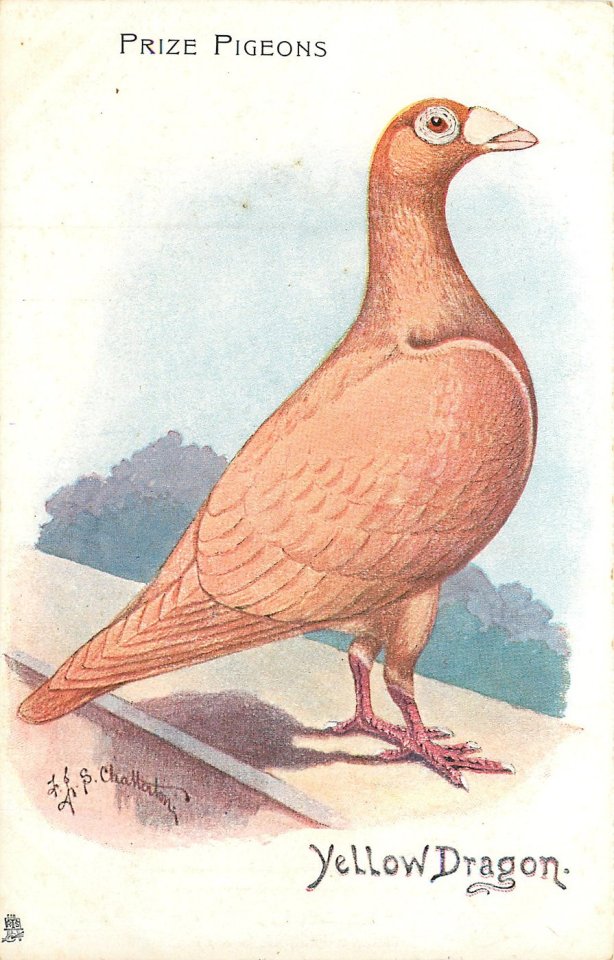


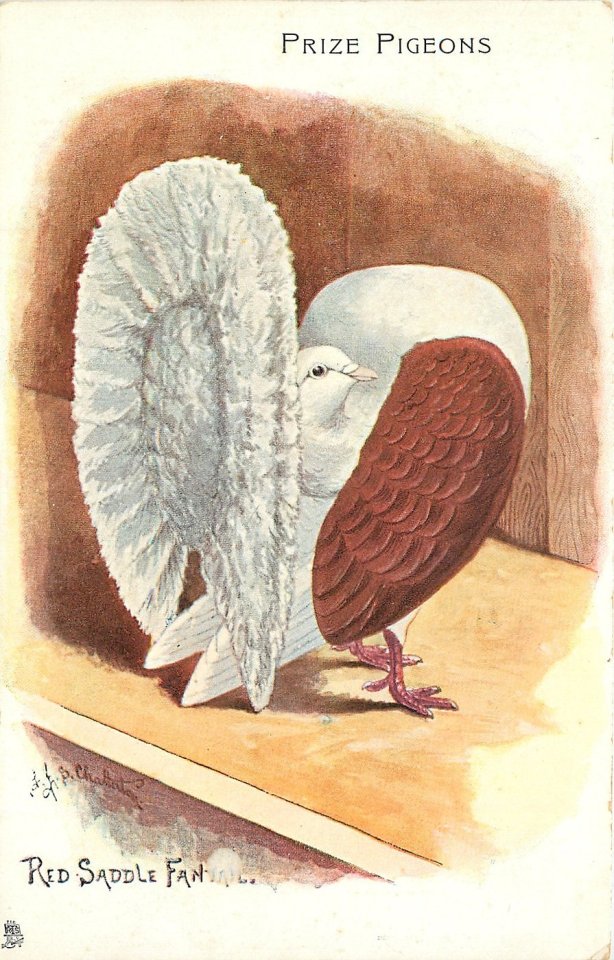
"Prize Pigeons" postcards (1908)
481 notes
·
View notes
Photo
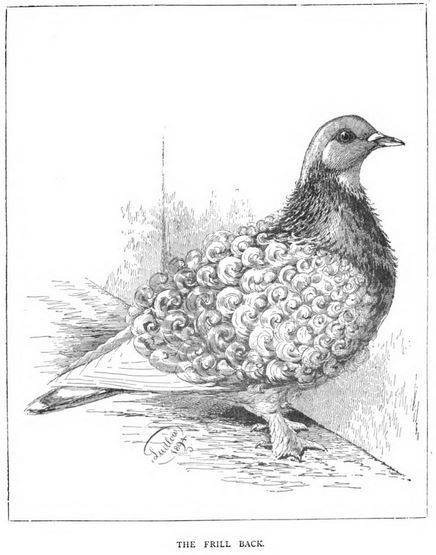

Frillback standard in 1895 on the left, actual (US-bred) Frillback from 1960 on the right
#kinda interesting how the breeders in the US apparently could only import subpar quality birds lol#pigeon history deep dive#<- ok that's the tag
1K notes
·
View notes
Photo

Best of Sundance 2021.
From pandemic-era stories, via portraits of grief, to the serendipitous 1969 trilogy, the Letterboxd crew recaps our favorite films from the first major festival of the year.
Sundance heralds a new season of storytelling, with insights into what’s concerning filmmakers at present, and what artistic innovations may be on the horizon. As with every film festival, there were spooky coincidences and intersecting themes, whether it was a proliferation of pandemic-era stories, or extraordinary portraits of women working through grief (Land, Hive, The World to Come), or the incredible serendipity of the festival’s ‘1969 trilogy’, covering pivotal moments in Black American history: Summer of Soul (...Or When the Revolution Could Not Be Televised), Judas and the Black Messiah and the joyful Street Gang: How We Got to Sesame Street.
The hybrid model of this year’s Sundance meant more film lovers across the United States—a record number of you, in fact—‘attended’ the prestigious indie showcase. Our Festiville team (Gemma Gracewood, Aaron Yap, Ella Kemp, Selome Hailu, Jack Moulton and Dominic Corry) scanned your Letterboxd reviews and compared them with our notes to arrive at these seventeen feature-length documentary and narrative picks from Sundance 2021. There are plenty more we enjoyed, but these are the films we can’t stop thinking about.
Documentary features

Summer of Soul (...Or, When the Revolution Could Not Be Televised)
Directed by Ahmir-Khalib Thompson (AKA Questlove)
One hot summer five decades ago, there was a free concert series at a park in Harlem. It was huge, and it was lovely, and then it was forgotten. The Harlem Cultural Festival of 1969 brought together some of the world’s most beloved Black artists to connect with Black audiences. The star power and the size of the crowds alone should have been enough to immortalize the event à la Woodstock—which happened the same summer, the film emphasizes. But no one cared to buy up the footage until Ahmir-Khalib Thompson, better known as Questlove, came along.
It would have been easy to oversimplify such a rich archive by stringing together the performances, seeking out some talking heads, and calling it a day. But Questlove was both careful and ebullient in his approach. “Summer of Soul is a monumental concert documentary and a fantastic piece of reclaimed archived footage. There is perhaps no one better suited to curate this essential footage than Questlove, whose expertise and passion for the music shines through,” writes Matthew on Letterboxd. The film is inventive with its use of present interviews, bringing in both artists and attendees not just to speak on their experiences, but to react to and relive the footage. The director reaches past the festival itself, providing thorough social context that takes in the moon landing, the assassinations of Black political figures, and more. By overlapping different styles of documentary filmmaking, Questlove’s directorial debut embraces the breadth and simultaneity of Black resilience and joy. A deserving winner of both the Grand Jury and Audience awards (and many of our unofficial Letterboxd awards). —SH
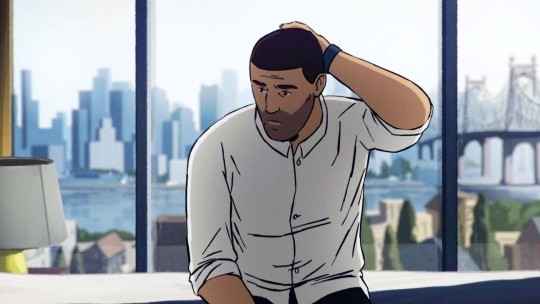
Flee
Directed by Jonas Poher Rasmussen
Flee is the type of discovery Sundance is designed for. Danish documentarian Jonas Poher Rasmussen tells the poignant story of his close friend and former classmate (using the pseudonym ‘Amin Nawabi’) and his daring escape from persecution in 1990s Afghanistan. Rasmussen always approaches tender topics with sensitivity and takes further steps to protect his friend’s identity by illustrating the film almost entirely in immersive animation, following in the footsteps of Waltz With Bashir and Tower. It’s a film aware of its subjectivity, allowing the animated scenes to alternate between the playful joy of nostalgia and the mournful pain of an unforgettable memory. However, these are intercepted by dramatic archive footage that oppressively brings the reality home.
“Remarkably singular, yet that is what makes it so universal,” writes Paul. “So many ugly truths about the immigration experience—the impossible choices forced upon people, and the inability to really be able to explain all of it to people in your new life… You can hear the longing in his voice, the fear in his whisper. Some don’t get the easy path.” Winner of the World Cinema (Documentary) Grand Jury Prize and quickly acquired by Neon, Flee is guaranteed to be a film you’ll hear a lot about for the rest of 2021. —JM

Taming the Garden
Directed by Salomé Jashi
There’s always a moment at a film festival when fatigue sets in, when the empathy machine overwhelms, and when I hit that moment in 2021, I took the advice of filmmaker and Sundance veteran Jim Cummings, who told us: “If you’re ever stressed or tired, watch a documentary to reset yourself.” Taming the Garden wasn’t initially on my hit-list, but it’s one of those moments when the ‘close your eyes and point at a random title’ trick paid off. Documentary director Salomé Jashi does the Lorax’s work, documenting the impact and grief caused by billionaire former Georgian PM Bidzina Ivanishvili’s obsession with collecting ancient trees for his private arboretum.
“A movie that is strangely both infuriating and relaxing” writes Todd, of the long, locked-off wide shots showing the intense process of removing large, old trees from their village homes. There’s no narration, instead Jashi eavesdrops on locals as they gossip about Ivanishvili, argue about whether the money is worth it, and a feisty, irritated 90-year-old warns of the impending environmental fallout. “What you get out of it is absolutely proportional to what you put into it,” writes David, who recommends this film get the IMAX treatment. It’s arboriculture as ASMR, the timeline cleanse my Sundance needed. The extraordinary images of treasured trees being barged across the sea will become iconic. —GG

The Most Beautiful Boy in the World
Directed by Kristian Petri and Kristina Lindström
Where Taming the Garden succeeds through pure observation, The Most Beautiful Boy in the World relies on the complete participation of its title subject, actor Björn Andrésen, who was thrust into the spotlight as a teenager. Cast by Italian director Lucino Visconti in Death in Venice, a 1971 adaptation of Thomas Mann’s novella about obsession and fatal longing, Andrésen spent the 1970s as an object of lust, with a side-gig as a blonde pop star in Japan, inspiring many manga artists along the way.
As we know by now (Alex Winter’s Showbiz Kids is a handy companion to this film), young stardom comes at a price, one that Andrésen was not well-placed to pay even before his fateful audition for Visconti. But he’s still alive, still acting (he’s Dan in Midsommar), and ready to face the mysteries of his past. Like Benjamin Ree’s excellent The Painter and the Thief from last year, this documentary is a constantly unfolding detective story, notable for great archive footage, and a deep kindness towards its reticent yet wide-open subject. —GG

All Light, Everywhere
Directed by Theo Anthony
Threading the blind spots between Étienne-Jules Marey’s 19th-century “photographic rifle”, camera-carrying war pigeons and Axon’s body-cam tech, Theo Anthony’s inquisitive, mind-expanding doc about the false promise of the all-seeing eye is absorbing, scary, urgent. It’s the greatest Minority Report origin story you didn’t know you needed.
Augmented by Dan Deacon’s electronic soundscapes and Keaver Brenai’s lullingly robotic narration, All Light, Everywhere proves to be a captivating, intricately balanced experience that Harris describes as “one part Adam Curtis-esque cine-essay”, “one part structural experiment in the vein of Koyaanisqatsi” and “one part accidental character study of two of the most familiar yet strikingly unique evil, conservative capitalists…”. Yes, there’s a tremendous amount to download, but Anthony’s expert weaving, as AC writes, “make its numerous subjects burst with clarity and profundity.” For curious cinephiles, the oldest movie on Letterboxd, Jules Jenssen’s Passage de Vénus (1874), makes a cameo. —AY
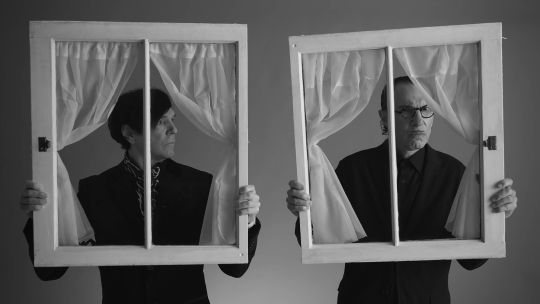
The Sparks Brothers
Directed by Edgar Wright
Conceived at a Sparks gig in 2017 upon the encouragement of fellow writer-director Phil Lord, Edgar Wright broke his streak of riotous comedies with his first (of many, we hope) rockumentary. While somewhat overstuffed—this is, after all, his longest film by nearly fifteen minutes—The Sparks Brothers speaks only to Wright’s unrestrained passion for his art-pop Gods, exploring all the nooks and crannies of Sparks’ sprawling career, with unprecedented access to brothers and bandmates Ron and Russell Mael.
Nobody else can quite pin them down, so Wright dedicates his time to put every pin in them while he can, building a mythology and breaking it down, while coloring the film with irresistible dives into film history, whimsically animated anecdotes and cheeky captions. “Sparks rules. Edgar Wright rules. There’s no way this wasn’t going to rule”, proclaims Nick, “every Sparks song is its own world, with characters, rules, jokes and layers of narrative irony. What a lovely ode to a creative partnership that was founded on sticking to one’s artistic guns, no matter what may have been fashionable at the time.” —JM
Narrative features

The Pink Cloud
Written and directed by Iuli Gerbase
The Pink Cloud is disorienting and full of déjà vu. Brazilian writer-director Iuli Gerbase constructs characters that are damned to have to settle when it comes to human connection. Giovana and Yago’s pleasant one-night stand lasts longer than expected when the titular pink cloud emerges from the sky, full of a mysterious and deadly gas that forces everyone to stay locked where they stand. Sound familiar? Reserve your groans—The Pink Cloud wasn’t churned out to figure out “what it all means” before the pandemic is even over. Gerbase wrote and shot the film prior to the discovery of Covid-19.
It’s “striking in its ability to prophesize a pandemic and a feeling unknown at the time of its conception. What was once science fiction hits so close now,” writes Sam. As uncanny as the quarantine narrative feels, what’s truly harrowing is how well the film predicts and understands interiorities that the pandemic later exacerbated. Above all, Giovana is a woman with unmet needs. She is a good partner, good mother and good person even when she doesn’t want to be. Even those who love her cannot see how their expectations strip her of her personhood, and the film dares to ask what escape there might be when love itself leaves you lonely. —SH

Together Together
Written and directed by Nikole Beckwith
Every festival needs at least one indie relationship dramedy, and Together Together filled that role at Sundance 2021 with a healthy degree of subversion. It follows rom-com structure while ostensibly avoiding romance, instead focusing on how cultivating adult friendships can be just hard, if not harder.
Writer-director Nikole Beckwith warmly examines the limits of the platonic, and Patti Harrison and Ed Helms are brilliantly cast as the not-couple: a single soon-to-be father and the surrogate carrying his child. They poke at each other’s boundaries with a subtle desperation to know what makes a friendship appropriate or real. As Jacob writes: “It’s cute and serious, charming without being quirky. It’s a movie that deals with the struggle of being alone in this world, but offers a shimmer of hope that even if you don’t fall in fantastical, romantic, Hollywood love… there are people out there for you.” —SH
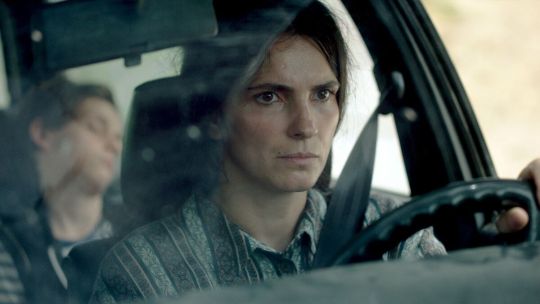
Hive
Written and directed by Blerta Basholli
Hive, for some, may fall into the “nothing much happens” slice-of-life genre, but Blerta Basholli’s directorial debut holds an ocean of pain in its small tale, asking us to consider the heavy lifting that women must always do in the aftermath of war. As Liz writes, “Hive is not just a story about grief and trauma in a patriarchy-dominated culture, but of perseverance and the bonds created by the survivors who must begin to consider the future without their husbands.”
Yllka Gashi is an understated hero as Fahrjie, a mother-of-two who sets about organizing work for the women of her village, while awaiting news of her missing husband—one of thousands unaccounted for, years after the Kosovo War has ended. The townsmen have many opinions about how women should and shouldn’t mourn, work, socialize, parent, drive cars and, basically, get on with living, but Fahrjie persists, and Basholli sticks close with an unfussy, tender eye. “It felt like I was a fly on the wall, witnessing something that was actually happening,” writes Arthur. Just as in Robin Wright’s Land and Mona Fastvold’s The World to Come, Hive pays off in the rare, beaming smile of its protagonist. —GG
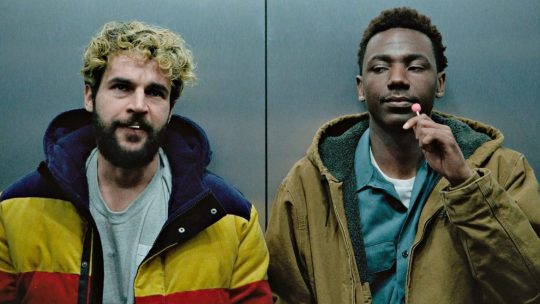
On the Count of Three
Directed by Jerrod Carmichael, written by Ari Katcher and Ryan Welch
It starts with an image: two best friends pointing guns at each other’s heads. There’s no anger, there’s no hatred—this is an act of merciful brotherly love. How do you have a bleak, gun-totin’ buddy-comedy in 2021 and be critically embraced without contradicting your gun-control retweets or appearing as though your film is the dying embers of Tarantino-tinged student films?
Comedian Jerrod Carmichael’s acerbic directorial debut On the Count of Three achieves this by calling it out every step of the way. Guns are a tool to give insecure men the illusion of power. They are indeed a tool too terrifying to trust in the hands of untrained citizens. Carmichael also stars, alongside Christopher Abbott, who has never been more hilarious or more tragic, bringing pathos to a cathartic rendition of Papa Roach’s ‘Last Resort’. Above all, Carmichael and Abbott’s shared struggle and bond communicates the millennial malaise: how can you save others if you can’t save yourself? “Here’s what it boils down to: life is fucking hard”, Laura sums up, “and sometimes the most we can hope for is to have a best friend who loves you [and] to be a best friend who loves. It doesn’t make life any easier, but it sure helps.” Sundance 2021 is one for the books when it comes to documentaries, but On the Count of Three stands out in the fiction lineup this year. —JM
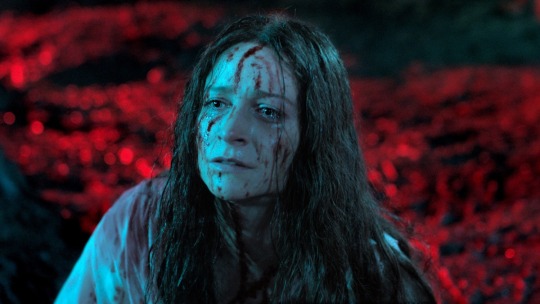
Censor
Directed by Prano Bailey-Bond, written by Bailey-Bond and Anthony Fletcher
The first of several upcoming films inspired by the ‘video nasty’ moral panic over gory horror in mid-’80s Britain, Prano Bailey-Bond leans heavily into both the period and the genre in telling the story of a film censor (a phenomenal Niamh Algar—vulnerable and steely at the same time) who begins to suspect a banned movie may hold the key to her sister’s childhood disappearance. Often dreamlike, occasionally phantasmagorical and repeatedly traumatic, even if the worst gore presented (as seen in the impressively authentic fictional horrors being appraised) appears via a screen, providing a welcome degree of separation.
Nevertheless, Censor is definitely not for the faint of heart, but old-school horror aficionados will squeal with delight at the aesthetic commitment. “I’m so ecstatic that horror is in the hands of immensely talented women going absolutely batshit in front of and behind the camera.” writes Erik. (Same here!) “A great ode to the video-nasty era and paying tribute to the great horror auteurs of the ’80s such as Argento, De Palma and Cronenberg while also doing something new with the genre. Loved this!” writes John, effectively encapsulating Censor’s unfettered film-nerd appeal. —DC

CODA
Written and directed by Siân Heder
A film so earnest it shouldn’t work, with a heart so big it should surely not fit the size of the screen, CODA broke records (the first US dramatic film in Sundance history to win all three top prizes; the 25-million-dollar sale to Apple Studios), and won the world over like no other film. “A unique take on something we’ve seen so much,” writes Amanda, nailing the special appeal of Siân Heder’s coming-of-ager and family portrait. Emilia Jones plays Ruby, the only hearing person in her deaf family, at war between the family business and her passion for singing. While Heder is technically remaking the French film La Famille Bélier, the decision to cast brilliant deaf actors—Troy Kotsur, Marlee Matlin and Daniel Durant—makes this feel brand new.
But it’s not just about representation for the sake of it. A sense of authenticity, in humor as much as affection, shines through. With a script that’s 40 per cent ASL, so many of the jokes are visual gags, poking fun at Tinder and rap music, but a lot of the film’s most poignant moments are silent as well. And in Ruby’s own world, too, choir kids will feel seen. “I approve of this very specific alto representation and the brilliant casting of the entire choir,” Laura confirms in her review. Come for the fearless, empathetic family portrait, stay for the High School Musical vibes that actually ring true. —EK
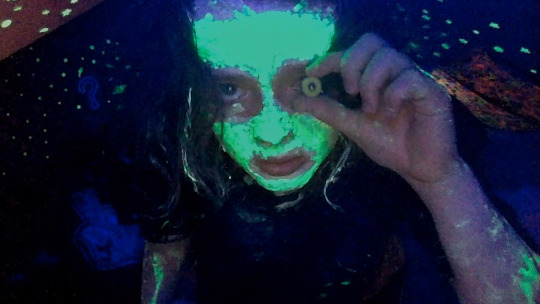
We’re All Going to the World’s Fair
Written and directed by Jane Schoenbrun
Perhaps the most singular addition to the recent flurry of Extremely Online cinema—Searching, Spree, Host, et al—Jane Schoenbrun’s feature debut ushers the viewer into a haunted, hypno-drone miasma of delirium-inducing YouTube time-suck, tenebrous creepypasta lore and painfully intimate webcam confessionals. Featuring an extraordinarily unaffected, fearless performance by newcomer Anna Cobb, the film “unpacks the mythology of adolescence in a way that’s so harrowingly familiar and also so otherworldly”, writes Kristen. Not since Kiyoshi Kurosawa’s Pulse has there been such an eerily lonely, and at times strangely beautiful, evocation of the liminal spaces between virtual and real worlds.
For members of the trans community, it’s also a work that translates that experience to screen with uncommon authenticity. “What Schoenbrun has accomplished with the form of We’re All Going to the World’s Fair is akin to catching a wisp of smoke,” writes Willow, “because the images, mood and aesthetic that they have brought to life is one that is understood completely by trans people as one of familiarity, without also plunging into the obvious melodrama, or liberal back-patting that is usually associated with ‘good’ direct representation.” One of the most original, compelling new voices to emerge from Sundance this year. —AY
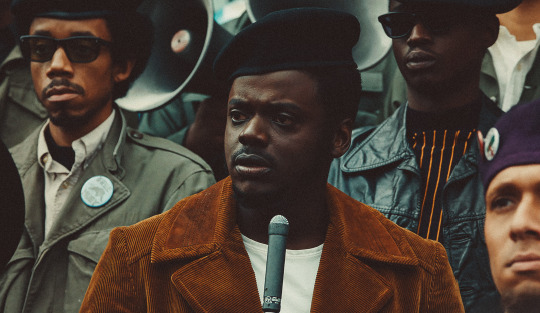
Judas and the Black Messiah
Directed by Shaka King, written by King, Will Berson, Kenneth Lucas and Keith Lucas
It was always going to take a visionary, uncompromising filmmaker to bring the story of Fred Hampton, the deputy chairman of the national Black Panther Party, to life. Shaka King casts Daniel Kaluuya as Hampton, and LaKeith Stanfield as William “Wild Bill” O’Neal, the FBI informant whose betrayal leads to Hampton’s assassination. Both actors have never been better, particularly Kaluuya who Fran Hoepfner calls “entrancing, magnetic, fizzling, romantic, riveting, endlessly watchable.”
Judas and the Black Messiah is an electric, involving watch: not just replaying history by following a certain biopic template. Instead, it’s a film with something to say—on power, on fear, on war and on freedom. “Shaka King’s name better reverberate through the halls of every studio after this,” writes Demi. A talent like this, capable of framing such a revolution, doesn’t come around so often. We’d better listen up. —EK

Pleasure
Directed by Ninja Thyberg, written by Thyberg and Peter Modestij
A24’s first purchase of 2021. Ironically titled on multiple levels, Pleasure is a brutal film that you endure more than enjoy. But one thing you can’t do is forget it. Ninja Thyberg’s debut feature follows a young Swedish woman (Sofia Kappel) who arrives in Los Angeles with dreams of porn stardom under the name ‘Bella Cherry’. Although Bella is clear-eyed about the business she’s getting into, Thyberg doesn’t shy away from any of the awfulness she faces in order to succeed in an industry rife with exploitation and abuse. Bella does make allies, and the film isn’t suggesting that porn is only stocked with villains, but the ultimate cost is clear, even if it ends on an ever-so-slightly ambiguous note.
Touching as it does on ambition, friendship and betrayal in the sex business, Pleasure is often oddly reminiscent of Paul Verhoeven’s Showgirls. Or rather, the gritty film Showgirls was claiming to be, as opposed to the camp classic it became. There’s nothing campy here. Kappel is raw and fearless in the lead, but never lets the viewer lose touch with her humanity. Emma puts it well: “Kappel gives the hardest, most provocative and transfixing performance I’ve seen all festival.” “My whole body was physically tense during this,” writes Gillian, while Keegan perhaps speaks for most when she says “Great film, never want to see it again.” —DC
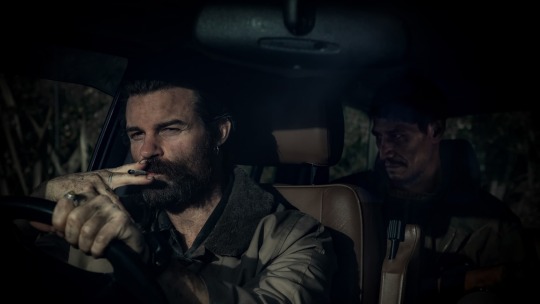
Coming Home in the Dark
Directed by James Ashcroft, written by Ashcroft and Eli Kent
A family camping trip amidst some typically stunnin—and casually foreboding— New Zealand scenery is upended by a shocking rug-pull of violence that gives way to sustained terror represented by Daniel Gillies’ disturbingly calm psychopath. The set-up of this thriller initially suggests a spin on the backwoods brutality thriller, but as Coming Home in the Dark progresses and hope dissipates, the motivations reveal themselves to be much more personal in nature, and informed on a thematic level by New Zealand’s colonial crimes against its Indigenous population. It’s a stark and haunting film that remains disorientating and unpredictable throughout, repeatedly daring the viewer to anticipate what will happen next, only to casually stomp on each glimmer of a positive outcome.
It’s so captivatingly bleak that a viewing of it, as Collins Ezeanyim’s eloquent reaction points out, does not lend itself to completing domestic tasks. The film marks an auspicious debut for director and co-writer James Ashcroft. Jacob writes that he “will probably follow James Ashcroft’s career to the gates of Hell after this one”. Justin hits the nail on the head with his description: “Lean and exceptionally brutal road/revenge film … that trades in genre tropes, especially those of Ozploitation and ’70s Italian exploitation, but contextualizes them in the dark history of its country of origin.” —DC
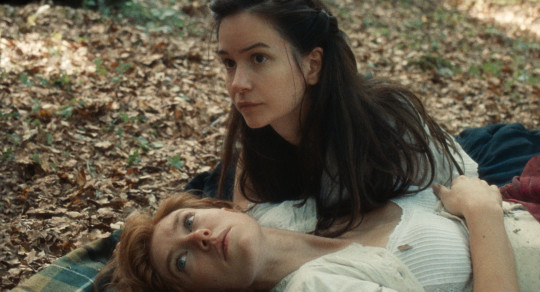
The World to Come
Directed by Mona Fastvold, written by Ron Hansen and Jim Shepard
Mona Fastvold has not made the first, nor probably the last, period romance about forbidden lesbian love. But The World to Come focuses on a specific pocket in time, a world contained in Jim Shepard’s short story ‘Love & Hydrogen’ from within the collection giving the film its name. Katherine Waterston and Vanessa Kirby are Abigail and Tallie, farming neighbors, stifled by their husbands, who find brief moments of solace, of astonishment and joy, together. What shines here is the script, a verbose, delicate narration that emanates beauty more than pretence. “So beautifully restrained and yet I felt everything,” Iana writes.
And you can feel the fluidity and elegance in the way the film sounds, too: composer Daniel Blumberg’s clarinet theme converses with the dialogue and tells you when your heart can break, when you must pause, when the end is near. “So much heartache. So much hunger. So much longing. Waves of love and grief and love and grief,” writes Claira, capturing the ebb and flow of emotion that keeps The World to Come in your mind long after the screen has gone silent. —EK
Related content
The 2021 Sundance Film Festival lineup by Letterboxd rating
Letterboxd’s ‘Official’ Top 50 of 2021
Awards Season 2020-2021: our awards-tracker list
Letterboxd’s Festiville HQ: our home for up-to-the-minute festival coverage
#sundance#sundance film festival#sundance 2021#sundance2021#questlove#summer of soul#black woodstock#shaka king#judas and the black messiah#letterboxd top 50#best of sundance 2021#letterboxd
11 notes
·
View notes
Note
You probably already get this question alot, but could I have some care tips (Cage requirements, food, basic care) and anything that might repel me from them? (Especially for a racing Homer - which is what I'm assuming they have here since pigeon racing is quite a big industry in my country) (I'd love to adopt but sadly that's not an option here since there's barely even dog rescues here) Thanks so much in advance!
I’ll start with what might repel you, starting with things inherent to the species, and then to potential effects of their personal history.
First thing’s first; DUST!!!
If you, or any one in your house hold, has dust related allergies or any respiratory issues at all, pigeons are not the pet for you.
They are dust monsters! For their size, the Columbidae produce more dust that any other domestic bird.
It is also a much finer dust. It floats in the air like thin smoke and takes a long time to settle, so you will breathe more of it with a group of pet pigeons than you would with parrots, chickens, quail, or song birds.
Definitely more than any mammalian dander that I know of.
Pigeons are only really territorial over what they consider a nest space.
Away from their nests, they are social and quite friendly, but the fiercely defend their nest from all comers.
If they are in a loft, or have free flight of a room, that aggression is constrained to the actual nest itself and anything with in about half a body length from the lip of it.
But if they are in a cage, the entire cage is space that they feel a powerful instinctive drive to defend.
Any uninvited entry is seen as an intrusion either by a predator or a rival, so I usually advise people not to attempt to physically interact at all with the pigeon in their cage.
Talking to the birds is fine, but all physical intrusion is seen as aggression that they have to defend against.
So, when you want to begin physically interacting with them, it’s best to invite them out into your room in the evening.
I’ll go into coop and home interaction training after the basic housing part.
Unless they are out of a sex linked pair, or you get them as fully mature adults, pigeons are absolute hell to sex.
Homers do become dimorphic as they age.
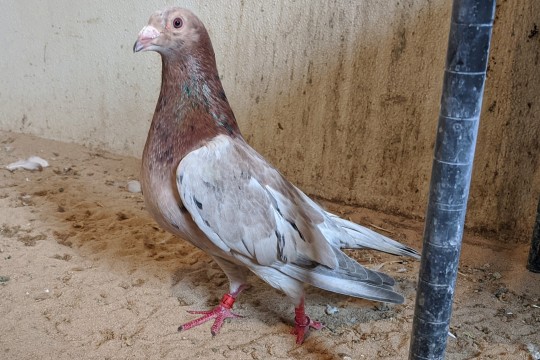
Karen is an adult racing homer cock.

Bird-bird is an adult hen of the same breed.
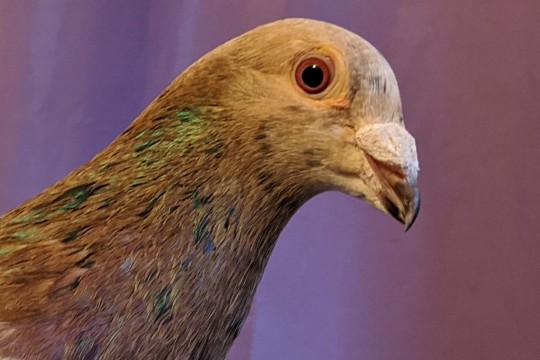
Look at Karen’s wattle (The thick skin above his nasal slits, at the base of his beak)
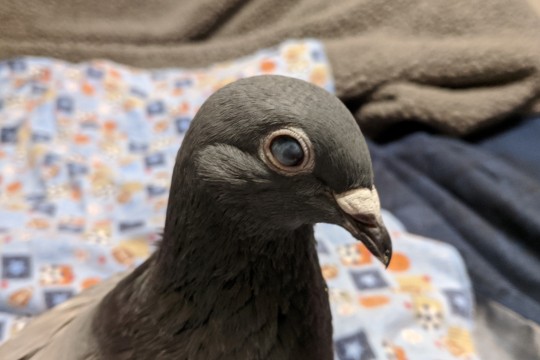
Now look at Bird-Bird’s.
His wattle is much bigger and more intricately developed than hers.
Her face is much finer featured than his.
He stands more upright.
She stands more horizontal.
But as peeps, they are nearly impossible to differentiate.
This is important, because the social behavior of cocks and hens and how it translates to humans tends to be VERY different.
Hens are VERY cuddly! Even into adulthood.
But adult cocks are platonically touch repulsed.
A flock mate is likely to make physical contact with a cock for one of two reasons: Another cock starting a fight, or a hen asking for sex.
They even make friends with flock mates through combat.
Until it sinks in otherwise, all attempts at physical contact with a cock is perceived as a challenge to a fight.
Non-aggressive contact with a cock is seen as an invitation for him to be your mate, and cock love is VERY pinchy!
Pigeon courtship consists of a three part ritual called Driving.
In the Chase trial, A cock will harass and bite a hen until she flees. If she was interested first, she’ll flirt to get his attention, and then fly off.
He HAS to chase her, keep up with her, and out maneuver her, all while herding her towards his nest so that she dives in when she’s too exhausted to continue to fly.
If he cannot out maneuver her, fly faster, and stay in the air longer than her, then her peeps will be more likely than her to be caught and eaten by a predator, and she will refuse that cock the opportunity to fill her eggs.
After she inspects the nest and has rested, she will try to leave. The second courtship trial revolves around blocking her exit and physically wrestling her back in until she is too exhausted to keep fighting him.
If he cannot block the generally smaller, weaker hen from leaving and fight her to a stand still, then he can’t hope to block another cock trying to force his way in, throw him out if he manages to pop in by surprise, or keep fighting him until he gives up.
Only after proving his stamina and strength to the Hen directly may he offer her a sample of the contents of his crop.
This is the sweet kissing part of courtship, after which they preen and cuddle and he’s allowed to step up onto her back and tread her.
This translates very poorly with a human partner, and if you have a cock as a companion, you have to be ok with a LOT of love bites before you can get to the soft cuddly part of the relationship.
Suddenly running up to you and biting out of nowhere is NOT aggression. They give LOTS of warning when they are upset.
Running up to attack you out of nowhere is a misguided attempt to begin Driving you, and he will go WAY over the top with it, because he is trying to impress a COLOSSUS with his physical strength, stamina, and tenacity.
You can understand how this could translate poorly to a human partner!
There are ways to respond to minimize the bitey bit, but we’ll get to those in another ask. This one is going to be VERY long as is.
Now, what we have just discussed is base line pigeon, with no outside components making anything more difficult.
Racers old enough to fly have been through daily training tosses; where they are grabbed, put in a basket, and released every day at increasing distances from the loft.
The best case scenario is a strong fear of hands from being grabbed and stuffed into the basket and occasionally restrained and injected with a vaccine.
The luckiest individuals have only had to navigate for miles every day to return to safety, food, and family.
Racing birds can also have to dodge hawks, or fly through inclement weather during training flights.
Some can even make it home severely injured.
Understandably, adult racers of either sex will need to be patiently worked through a STRONGLY reinforced fear of hands.
We have lots of posts discussing how to work with fearful pigeons, and I’ll be happy to go into it again in more detail, but that’s another for a different post.
Basics of care for pigeons are very simple.
They are strict granivores. Seeds are all they can digest, but they can eat a very wide variety of seeds. The more variation, the better.
Pigeons do not hull their seeds. They swallow them whole, and depend on the hulls as vital dietary fiber, so don’t give them seed that is already hulled.
Their diet should involve as much variety of seed, grains, and legumes as you can get your hands on, the size of an unpopped kernel of popcorn or smaller (Most breeds can;t swallow seeds much bigger than that) with some source of calcium available.
You can have a separate dish of oyster shell, or you can sprinkle powder in a single birds daily meal, or add liquid calcium to their water dish.
NOT all of those at once! Calcium can be overdosed!
Which ever method works most easily for you and your bird.
Pigeons are intensely social birds that get most of their enrichment from interaction.
They are happiest as free roaming house pets, like a cat or dog, that can come see you or go do their own thing as they choose.
Pigeons are smart enough to learn house rules.
Understandably, that is not an option for every one, and free roaming unsupervised before they learn the house rules can be dangerous.

If you cannot let the bird free roam their own room, you can easily modify a dog crate to house them comfortably.
They need square perches. Because they are cliff nesters, round perches put painful pressure on the ball of their feet, making walking painful.
I like to cut garden stakes to length and wire them into place.
A corner bunny litter pan is a decent nest box, but not necessary. They will nest just as happily in a cheap dog food dish.
Pigeons are ground foragers, so they prefer a shallow dish of food on the floor of their enclosure.
Ideally, the modified crate cage for the pigeon should be used like it would be for a pet dog; That is not where the animal lives full time.
That is where it sleeps at night or hangs out when you aren’t home to supervise it, until it learns the house rules.
Toys are very simple, because their interaction tools are very limited.
Pigeons can recognize themselves in mirrors and love to play with them.
They enjoy bathing in a dish of water about hip-deep.
They can have sand or straw filled forage boxes to hunt for treats like safflower seeds in.
Stick-shaped, Shiny, and Jingly is their holy trinity of toy characteristics.
q-tips with the cotton tips cut off, tooth picks with the points clipped, wicker kitty balls with jingle bells inside, bread ties with jingle bells that are too big to accidentally swallow twisted to either side, or made into a jingly ring, are all cheap, simple toys that a single pet bird will have fun playing with.
I mentioned coop training earlier, and it’s super simple.
Starting in the evening, open the door to the cage and invite the bird out.
Don’t hang around waiting for it to come. Go settle in to do something quiet and sedentary, like reading a book or surfing the net.
Pigeons are naturally curious, and the best way to work then through the fear of people they may have developed is to be as nonthreatening as possible and reward their curiosity.
Talk to them to desensitize them to your voice and start teaching them how you communicate.
They will eventually grow brave enough to come explore you yourself.
A quiet, pleased greeting will reward them by not startling them.
Have safflower seeds available, but don’t try to reach out to give it to the birds.
Let them discover that you have them, and be still and non-reactive when they take some. Offer verbal praise, but don’t start trying to move until they ease away from automatic flightiness.
I specify beginning this process in the evening because trying to get a bird back into the crate before it trusts you is very difficult and your best bet to avoid making it afraid of you despite your friend-making efforts is to avoid having to chase it back into its pen at the end of flight time.
Starting these in the evening allows you the option to avoid chasing entirely just by turning off the lights.
At the end of out time, give a verbal warning like “Lights out” or “Bed Time”, and then wait a minute or two before actually turning off the light.
Pick the bird up in the dark, and return it gently to its enclosure.
It will begin to associate the “Lights out” or “Bed time” warning with the lights going out, and eventually learn to fly back to the pen in the space of time before the lights actually go out.
That’s about the skin and bone basics of care.
Please, by all means, send more asks for more information on any aspect or detail of pet pigeon keeping.
I am always happy to answer. ^v^
176 notes
·
View notes
Text
I posted this on my phone so I'm sorry about the layout! This is my first fanfic! I hope you all enjoy!
Juvia Lockser was sitting in her history classroom in Magnolia, Fiore. Her head was lying on her arms and she was fighting to stay awake while her teacher Mr. Porla droned on and on about the origins of the country.
Suddenly, her eyes were drawn to just outside the classroom window. As her brain finally understood what she was looking at, Juvia flung her head up. Outside in the snow, there was a shirtless boy waving a sword around while weird looking pigeons dive bombed all around him. She could tell he was talking, or more likely shouting, while he was attacking the strange birds.
Juvia shook her head back and forth, trying to regain her senses. The images, however, just wouldn’t transform into a normal scene. She raised her hand slowly.
“Yes, Miss Lockser?” Mr. Porla questioned.
Juvia didn’t quite realize that he had spoken yet. One of her classmates elbowed her, and she cleared her throat to the sound of titters and jeers.
“Um… Mr. Porla, may I go to the restroom?” she asked quietly.
He sighed. “Yes, Miss Lockser.”
Juvia scrambled out of her seat while her classmates laughed again. She ignored them and continued on into the hallway. Instead of going in the direction of the bathroom, however, she ran through the halls and out the door of the school.
While she ran, she thought about her classmates and how mean they were to her all the time. To them, Juvia is just the gloomy rain girl, who gets along better with fish than with real people. It wasn’t her fault that she loved fish or that it always seemed to rain when she was upset or sad. It wasn’t her fault she was an orphan who has never had a real friend or any family. She sighed and shook her head to clear it. She had to help the strange boy.
When she got closer to where she thought he would be, she could hear shouting. She strained her ears to try and catch what he was saying, but it sounded like it was in a completely different language.
How odd, she thought. I wonder if he is from another country or something.
Juvia finally caught another glimpse of the boy. He was very cute in a scruffy way, she thought offhandedly. Spiky black hair covered his head, not quite covering up a thin scar on his forehead over his eyes. Eyes that were a deep, dark blue, almost grey looking framed by long lashes. His mouth, when he wasn’t shouting, was set into a thin line, and his brows were furrowed.
Not that that was a surprise, she thought to herself. He must be concentrating very hard.
The most notable feature, though, was his set of abs. The muscles were very defined, cut into clear eighths. Juvia had to try very hard to pull her eyes up to his face. Once she did, however, she saw that the boy had gotten a cut on his cheek. Seeing the blood spurred her into action.
She stopped to pick up a frozen rock from the ground and jumped in front of the boy before the birds could do him any more harm. From behind her, she could hear him make out a strangled “Gahhh!”
She didn’t stop though. She swung her rock at the birds and screamed at them. The boy pulled Juvia back behind him before they could dive at her.
“Stay behind me,” he grunted, then swung upwards with his sword. There was a metallic shinnnk, and the birds were gone, leaving only a yellow powder that blew away on the wind.
Juvia stared at the place where the birds’ bodies should have been. “Where… where are the birds?”
The boy turned to stare at her incredulously. “Where are… By the gods, girl, what do you think you were doing? I had that under control and then you just came out of nowhere, with a rock. What were you thinking?”
Juvia glared at him. “I saw you outside the window, fighting for your life. I just wanted to help you! You could act a little grateful that someone was willing to help!”
“About that. How did you even see the Stymphalian birds? Are you a demigod, too?”
Juvia looked at him blankly. “A what?”
“How old are you?”
“Excuse me?!”
The boy rolled his eyes. “Girls. I am only asking because you seem a bit old to have not been claimed yet. How old are you?”
“I am fifteen. You never answered my question by the way. Where did the birds go?”
The boy glanced back at her. “Oh, yeah. They were monsters. Stymphalian birds. They were dispelled back to Tartarus. That is where monsters go when they die. ”
Juvia laughed. She had no idea what this boy was talking about, but it made so much sense to her. She wasn’t crazy after all. In all her life, whenever something strange happened, like the weird one eyed man who followed her when she was 8 that suddenly vanished when she hit him with a shovel, or the time she saw a lady on the street with two snake legs, the adults in her life told her she must have been imagining things. Nobody ever believed her when she said that the man only had one eye, or the lady had two snakes where her feet should be. Juvia could hardly believe herself. But now, this strange, handsome boy could see the weird things, too.
The boy glanced around the two of them nervously. “Come on. You need to come with me.”
Juvia stopped laughing. “I don’t even know your name. Why should I go anywhere with you?”
He smirked at her, which looked so handsome on him that it made her stomach do a little dance. “Gray. Gray Fullbuster. Now come on. I need to bring you somewhere safe. We definitely don’t need another monster to find us.”
Juvia hesitated, but she reached out to grab Gray’s outstretched hand. “Okay.”
He smiled a full blown smile and started running, pulling her along behind him. Juvia smiled too, as she ran with Gray to start her new life.
5 notes
·
View notes
Text
elf primer
As part of a larger joint project (a lore reading order timeline), I wanted to write a post documenting all of the elf and kindred-related weirdness in the story. Once you start diving really, really deep into trying to piece elfkindred information together, you'll find that lots of things contradict each other or become jumbled. This is in part due to our server's translation and in part just because the story legitimately retcons itself. There were also a lot of theories and misconceptions which I wanted to spend some time discussing. So here is some information that will help those who are interested in reading.
By the way, huge spoilers ahead for the newest CN hell event, which has been given the fan nickname “Moonless Voyage”. The translations I used are linked at the end!
Main Cast
Chloris: The duty-bound Prince of Forest Elves. He participated in the war between kindred and elves a thousand years ago. He has very few desires as he's very focused on the well-being of the forest. He's also very powerful. Has been kept in the dark about his family history.
Cesare: The brother of Chloris and the current Lord of Kindred. He was exiled to Shadow City, the world within Lake Bovaly, a thousand years ago. Strongly wishes for Kindred to be simply allowed to live in the forest again, after that right was stolen from him when he was young, and secretly wishes he and Chloris could be normal brothers. Now, he also wants to break the Blood Curse because it affects all Kindred even if they just have the desire to hurt others (not for the same reasoning as Nidhogg).
Lakris: The second Prince of Forest Elves. Stated by Cesare to simply be "a part of him" that was taken. Looked just like Cesare.
Elven Queen: The mother of Chloris and Cesare. Anti-war and fiercely protective of the elves even at the cost of her own Kindred loved ones.
Helsin (Blood Lust): The Lord of Kindred who served as the leader of Shadow City while Cesare was missing. Her primary goal is to break the seal of Shadow City once more.
Evelyn (Flickering Pistill): An elf who was invited to Shadow City by Helsin and subsequently tortured. She became the final seal for Shadow City, never truly dying. Her story is well-known among those in the Pigeon Forest and Shadow City.
Timeline
(Note: Next to the occurrence, I wrote where you can find the source/a more detailed description of the lore.)
Many years ago: Forest Elves (Chloris' kind) guarded the Pigeon Forest since it came into existence. (Chloris 1)
Elves who sought to cleanse the world were corrupted by the miasma they encountered, and became the Kindred. (Moonless Voyage)
>1000 years before Year 680, New Era: Chloris and Cesare were born to the Elven Queen and the Lord of Kindred, who were lovers but could not be together. The two twins did not meet. (Jealous Phantom)
~1000 years before Year 680, New Era: Tensions broke out between Kindred and Elves. The Elven Queen persuaded the Lord of Kindred to take all of the Kindred out of Pamir Forest (north of main Pigeon Forest) and bring them to Shadow City so there would be no more war. Lord of Kindred obliged, and opened up Shadow City, an action that took most of his strength and ultimately killed him. Every Kindred in Pamir Forest went to Shadow City. (Jealous Phantom)
Cesare's father died, Cesare became the new Lord of Kindred, and the Elven Queen made one last visit to him to say her final goodbye. Cesare pleaded with her to change her mind, but she turned her back on him and left. (Jealous Phantom)
The Elven Queen died (as was told to Cesare) or went missing. (Jealous Phantom/Wake Up from Dream)
Cesare would occasionally watch Chloris play the harp from the other side of the lake, aware that Chloris was his brother. (Jealous Phantom/Flower Feather)
Cesare continued to fight the elves. During a fight, the Elven King (Cesare's uncle on his mother's side) told him that his mother had left some words for him before she died. This was a ploy to distract him and disarm him. Elven King then picked up Cesare's sword, Dark Verdict, and stabbed him with it. Cesare sank to the bottom of the lake. (Moonless Voyage)
Lakris appeared under the Tree of Life for the first time. However, he was asleep during the war. (Wake Up from Dream/Chloris 4)
At some point, the King also died in battle. (V2: 4-2)
[Assumption] Any remaining Kindred that were in Shadow City left, and so did Elaine, leaving the elves and her sister Rachel behind in the forest. The seal between Shadow City and Pigeon Forest formed. (Minstrel of Time)
Helsin became the Kindred Lord and the most powerful person in Shadow City and amassed many followers that feared her but respected her. (Moonless Voyage)
Helsin, who wants to break the seal between Shadow City and Pigeon Forest, invited Evelyn to Shadow City to torture her. Evelyn doesn't die; instead, she ends up becoming the final seal, believing it to be atonement for everybody who participated in the war. (Blood Moon)
Year 670, New Era: Cesare stayed at the bottom of Lake Bovaly for nearly a thousand years until Nidhogg one day swam down and retrieved the Dark Verdict sword, stabbing him and releasing him from the seal that the Elven King had placed on him that trapped him there. (Mentioned in Ice Abyss Echo, Dark Verdict suit, and V2: 4-SS2. The year and more clarification on what happened is given in the Miraland Civilization Files book.)
Cesare returned to Shadow City, to the surprise of Kindred there, who worshipped Helsin and viewed Cesare as only a legend considering how long he had been in the lake. (Moonless Voyage)
Infighting began between Kindred who were loyal to Helsin and Kindred who were loyal to Cesare, but Helsin declared her loyalty to Cesare, who went forth and did his best to improve the quality of life in Shadow City. (Moonless Voyage)
Year 680: Cesare and Kindred spirits gather power in Pamir Forest again, using Noah as an agent to stir up chaos and attract the attention of Chloris. Chloris and Lakris go to investigate, and Lakris disappears into a heavy fog as they walk. Chloris goes to the Kindred castle alone and meets Cesare for the first time. It's implied that Lakris was the elven part of Cesare all along, and Cesare reclaims Lakris. Cesare disappears in the light of the Dawnblade. (Chloris 4)
Nikki, Mela, and Momo accidentally get hoodwinked and sent into Shadow City where they nearly get eaten alive by some hungry Kindred. Chloris finds this out and makes the decision to remove the seal between Shadow City and Pigeon Forest to save them. (V2: Chapter 3)
Most of Chloris's strength is used in removing the seal. Cesare escapes Shadow City and bites Chloris, transferring his memories and weakening him further. (V2: 3-SS2)
Elaine and Rachel (boat lifetime sisters) along with Nikki and co attempt to find a way to heal Chloris but he falls unconscious. (V2: Chapter 4)
When the seal is removed, Evelyn (Helsin's prisoner) disappears. Helsin goes mad with desire and experiences severe backlash from the Blood Curse, so she asks to be restrained. (Moonless Voyage)
At some point, Chloris wakes back up. (That one Pigeon welfare suit)
Cesare decides to break the Blood Curse. He recruits Helsin for help and they leave Shadow City and go back to Pigeon Forest. Helsin fights off Elven soldiers with her whip while Cesare tries to remove a giant crystal within the Tree of Life that binds Kindred under the Blood Curse. Chloris approaches and Cesare explains his reasoning for trying to remove the crystal, also dropping the bomb about the secrets behind their parentage. (Moonless Voyage)
Chloris conducts some elfin glowing crystal magic that renders the Kindreds immobile. Peace falls over the entire forest. The backlash of the Blood Curse that the Kindred constantly experienced disappears. (Moonless Voyage)
Cesare orders all the other Kindred to return to Shadow City. He does another bonding ritual with Chloris which seems to transfer energy to Chloris. Though it's not over between them, Cesare returns to Shadow City once more. (Moonless Voyage)
NOTE: Some assumptions had to be made for this timeline. The biggest one is that even after Shadow City had been opened, the war between Kindred and Elves continued until the seal was formed at a later date. Without this assumption, multiple events described in the story do not make sense.
FAQ
How much time passed between the war and the year 680?
Certain parts of our translation refer to it as "thousands of years", but truthfully, it was actually just a thousand years that passed. (Thank you Athena for clearing this up!)
This is almost definitely not an exact number, especially given everything else that was happening with the timeline across Miraland, as well as how many different events were written as occurring a thousand years ago.
Are Chloris and Cesare half brothers?
For a long time, this is what most people (including myself) believed. This is at least in part because of a few lines within the story suit Jealous Phantom which stated:
"Cesare often think[s] about his mother while sitting on bough in the forest, imagining how his brother, who has the blood of the Elven Guardian, spends days with mother under the bright sunlight."
This seemed to indicate that Chloris had some elven parentage that Cesare did not, which both made him a "full" elf and afforded him privileges Cesare couldn't have.
However, we learned recently that this is not true. With the release of the most recent hell event, both Chloris and the fandom was confronted with the truth, which is that Chloris is also born of Kindred and they are full brothers.
Cesare: “and you, the great Elven King, my fated twin, are also born of kindred blood.”
[...]
(a truth he has tried to ignore revealed, Chloris felt dizzy. He closes his eyes tightly.)
(Translation: RavenBlue)
We also learn that the old Elven King was actually Chloris' (and Cesare's) uncle, not his father.
What if Cesare was lying? To tell you the truth, it is highly unlikely that that's the case. Firstly, even Chloris himself recognizes the truth that he was born from a kindred. Secondly, it's very uncommon for half-sibling twins of different parentage to occur, to the point where even fans were second guessing and wondering if this was really what the writers meant to imply. Thirdly, we now don't even have another candidate for Chloris' dad now that we know the king was his uncle and not his father.
Does this make Chloris kindred, per se? Not really. He doesn't display any of the symptoms of being a kindred. The most likely explanation is that he just "didn't get the Kindred gene" while his fraternal twin Cesare did.
How did Cesare fall to the bottom of the lake?
There are now three different versions of this, only one (the most recent one) which actually seems canon-compliant:
First Wind: The Elven King stabs Cesare with the Dawnblade; his body is later dropped in the bottom of the lake.
Jealous Phantom: Cesare was watching Chloris play the harp when his sadness and the light overwhelmed him and he toppled into the lake. (This one could be metaphorical, even though the metaphor doesn't match the other explanations.)
Moonless Voyage: The Elven King stabs Cesare with his own Dark Verdict; his body falls to the bottom of the lake.
The most canon-compliant one is the Moonless Voyage one, which matches the other bits of interconnecting lore about how Nidhogg acquired the Dark Verdict.
Is Evelyn the mother of Chloris and Cesare/the Elven Queen?
This is a long one so buckle in. (Yes, I touched on this briefly in my last post.)
First of all, I want to reiterate that this was never explicitly stated anywhere. Evelyn was never called the queen and was never described as having children, and the Queen's name was never given. I still believe this is up to interpretation. So here, I'll just lay out all the evidence for both sides. Right now, I don't think it's possible to say one way or another.
Some of the evidence for this theory includes the following:
In Chloris' fourth Dreamweaver, Moon Night Poem, Chloris' mother is mentioned by Cesare.
Duke Cesare: "He was so brave and fearless... even when all hope was lost, he refused to surrender, going so far as to put his life on the line. I simply obliged him... nothing more. That's typical of the forest elf, just like your mother."
This indicates that Chloris' mother had sacrificed her life or was self-sacrificing in some way. Of course, Evelyn is also well-known for her sacrifice, as she became the final seal of Shadow City, and her sacrifice is discussed throughout volume 2, chapter 4:
Nikki: "Those Kindred and elven specters in the Shadow City... They longed for sunlight even they knew it would burn them. Evelyn wanted no bloodshed and she sacrificed herself for peace."
Does Cesare and Chloris' mother make a sacrifice? Well, it's said in Jealous Phantom that it's a very difficult decision for her to banish the Kindred, including her lover and Cesare, to Shadow City for the sake of the elves. That's the only thing I can think of that would qualify as a sacrifice.
One potential hint that Evelyn could have been the queen is from this line from Flickering Pistill:
Evelyn guards the quiet Pigeon Forest. When she bleeds, the reflection of stars will turn to white flowers.
However, in my opinion this is pretty weak evidence because pretty much every forest elf is said to guard the forest (as stated in basically any Chloris dreamweaver you look at).
As well, their circumstances also seemed to line up. In the spirit items from Chloris' fourth dreamweaver, Destined Twins and Wake Up from Dream, it's stated:
Every generation, elves will have 2 guardians who protect the Pigeon Forest in turn, a Sword and a Moon.
Chloris is the first guardian and Lakris didn't appear under the Life Tree till Elf Queen went missing.
We also know that Evelyn herself leaves Pigeon Forest to go to Shadow City forever and act as the seal. However, this is largely viewed as a choice (a "sacrifice") and Evelyn herself was willing to take this on. Again, it's really up to how you read it.
Here's the evidence against Evelyn being their mother:
In the most recent CN hell event (Moonless Voyage), we get confirmation that Helsin was the Lord of Kindred while Cesare was in the bottom of Lake Bovaly for nearly a thousand years. Now that Cesare has been woken up, Helsin is subservient to him. The story of Evelyn is mentioned to him, and he knows about it, but he simply does not care. It's explicitly stated that he has no interest and only cares about Helsin for her power.
Cesare’s Underling: “Ever since the seal of Shadow City was broken, Evelyn, who was previously imprisoned, disappeared. Since then, master Helsin’s desires became more and more cruel, and the backlash on her body became stronger and stronger…..”
(Cesare has heard of the struggle between Helsin and the elf she imprisoned. But he holds no interest in this. All he needs is Helsin’s power.)
(Translation: RavenBlue)
Cesare was told that his mother was dead (mentioned in both Jealous Phantom and Moonless Voyage). In the year 680, he also still seems to believe his mother sacrificed her life for something (see the quote from Chloris 4 I posted above). It's incredibly weird that he would show no interest in this development if she was his mother; it's displayed elsewhere in Moonless Voyage that he still showed interest in his mother even after she abandoned him. But it makes perfect sense narratively if Evelyn is not actually his mother and is just the self sacrificing elf of legends.
The next part is that the timeline does not line up.
It makes much more sense if everything regarding Evelyn, and all of Blood Moon, happened after Cesare fell to the bottom of the lake.
The war between Kindred and Elves already seems to be over as described in Flickering Pistill, as Evelyn is "atoning" in part for the winners of the war.
Helsin is described as the Kindred Lord in Blood Lust, but we know from Jealous Phantom that Cesare inherited the position from his father. Considering we know Helsin was the one in power while Cesare was at the bottom of the lake, it only seems logically consistent that she would only obtain that title after he disappeared.
Lastly, there is simply no reason to not say so if Evelyn is Chloris and Cesare's mother. The story of Evelyn is well known in both Shadow City and Pigeon Forest, and even Cesare who has been asleep for a thousand years knows it. If Cesare knows they are the same, and a great deal of Kindred lore is told from Cesare's perspective and centered around his character development, I literally see no point in continuing to talk about both Evelyn and their mother and not just say they are the same. The same is also true for Chloris, who would also have heard of Evelyn. There is nobody left who cares about Chloris and Cesare's mother to reveal the plot point to. But LN definitely seems to be fond of pulling stunts like this, so it's still hard to say.
What about Wind's Whisper?
There is another character called Evelyn in Wind's Whisper. Evelyn is described as a tree spirit in this, and it distinguishes her from "Pigeon Elves" because she hibernates. However, after asking about the original Chinese text, I have learned that there was a word left out in our translation; Evelyn is a tree elf/spirit, but she hibernates unlike other Pigeon elves.
The words for spirit and elf in Chinese are related, and it's possible that Evelyn is the same type of elf as Chloris even though it's written differently in Chinese.
While I'm not really sure if the Evelyn from Wind's Whisper has anything to do with the rest of the story, it's a moot point to me because whether it does or doesn't, it doesn't add any additional understanding or insight.
Thank you to Athena, RavenBlue, and bamboo snek for clearing this up!
Translation Credits
RavenBlue#2752
for their wonderful and speedy translations of the new hell event stages
for their official Miraland timeline translation
As well to athena#2202 and bamboo snek#3897 for sharing and explaining the original Chinese meaning for parts where our translation got butchered! (Noted above)
#love nikki#love nikki lore#love nikki theories#elves#character: chloris#character: cesare#character: evelyn
5 notes
·
View notes